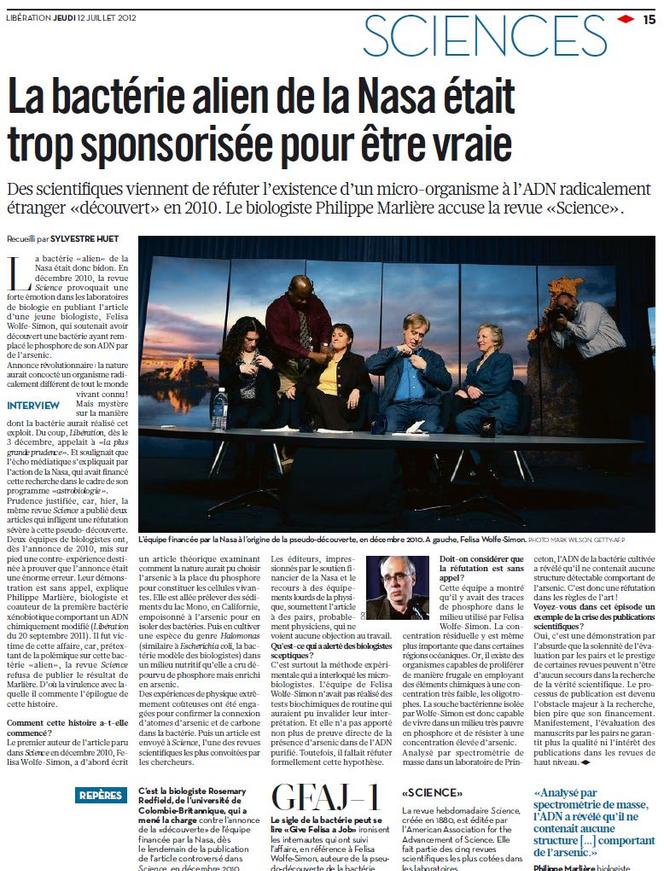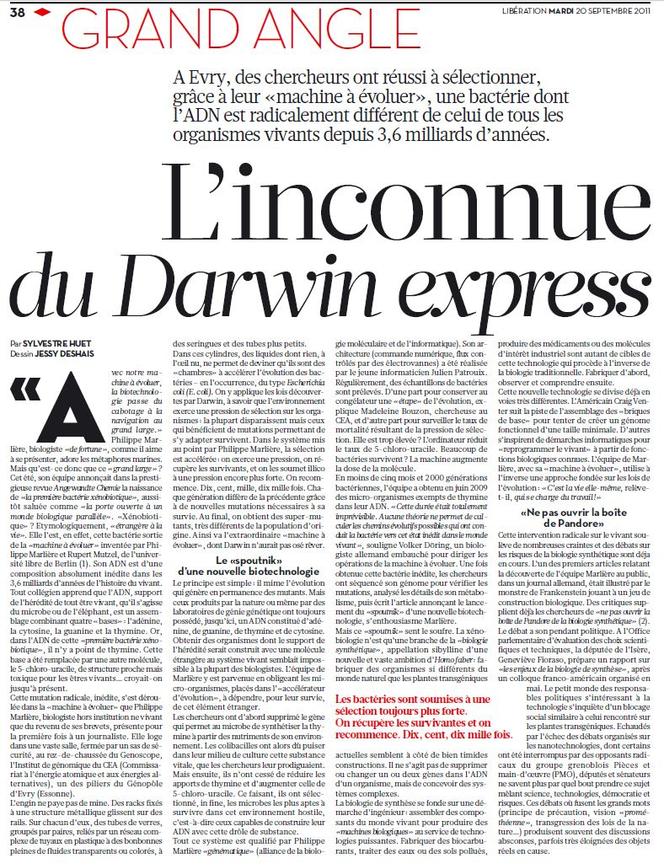Lessons from the end of the “alien bacteria”
On Friday, December 3, 2020, I published a full-page article in Libération , the newspaper I worked for from 1995 to 2016. It reported and commented on the publication, that same day, of a scientific study in the journal Science , which the American Association for the Advancement of Science has published since 1880. A journal that is part of the top three so-called "primary" publications where scientists talk to scientists about their work, under the supervision of their peers. The article I published was... bizarre. I reported on the discovery announced by a small team, funded by NASA's Astrobiology Institute, of a strange bacterium in Mono Lake, located in a California desert. This lake is filled with hypersaline, alkaline water laced with arsenic. As for the bacteria, announces the team led by a young biologist, Felissa Wolfe-Simon, it is a kind of alien, since it would have made arsenic a major constituent of its biology, instead of the phosphate used by all living beings on Earth.
The article is bizarre, because the only scientific opinion cited is that of Marie-Christine Maurel, a biochemist specializing in work on the origin of life, who sees it as "a solid work." And yet, the journalist who signed it, your servant, goes overboard with doubt, despite the endorsement of Science and therefore, a priori, a careful rereading likely to prevent publication by experts commissioned for this purpose by the journal. Ironically, I imply that the young biologist has "a fine and effective understanding of the sociology of science: the fight for funding and media coverage of research is definitely a combat sport that she conducts successfully." I emphasize that "the mystery surrounding this strange bacterium is still thick." I suggest that "the greatest caution is therefore required" (on the conclusions put forward by the researchers). And I end the article with a long discussion of NASA's efforts to mobilize American public opinion on the search for life in the solar system in order to solidify its funding by the US Congress.
On Thursday, July 12, I published an article of the same length, a page, titled "NASA's alien bacteria was too sponsored to be true." In it, I recounted the demonstration by two articles published by Science of the "bogus" nature of the 2010 announcement and which refuted it according to the rules of the art of discussion between scientists. The article includes an interview with a French biologist, Philippe Marlière. The refutation is based on the absence of evidence provided by Félissa Wolfe-Simon's team, but above all on the demonstration that the bacteria is in reality like other living beings on Earth; it lives with phosphorus, the tiny quantities of which it is capable of using in the environment, and that it does not live thanks to arsenic but in spite of it, resisting it, even at high doses. And above all, it does not contain this poison in its biological mechanisms.

At that time, biologists asked the journal Science to retract the 2020 article. A retraction, in the customs and traditions of science, is to warn the readers of the article that its content has been refuted and that it should therefore no longer be considered valid. Often, retractions are made by the authors themselves, who were the first to realize an experimental, methodological, or calculation error. In this case, no one is to blame. Anyone can make a mistake; what matters is to correct it when you notice it. But the signatories of the 2020 article refused to retract their article. This is therefore a decision by the management of Science , which explains the very long time it took to do so by a tightening of its ethical rules compared to 2010. As for the signatories' refusal, it will not improve their image in the scientific community. A community where the most acidic had used the name given to the bacteria, GFAJ, to describe the study as "Give Felissa a Job" .
Bad science drives out good scienceThere is a little-known aspect to this affair, which I did not report at the time so as not to betray a source. In this case, Philippe Marlière. This biologist had indeed, shortly after the 2010 article, sent to Science a proposal for an article relating to experimental work carried out in Evry (Essonne). A work whose result was a world first: the production by a Darwinian selection process of the first bacterium whose DNA had been chemically modified. The first "xenobiotic" bacterium, he said at the time. The DNA of living beings on Earth is made up of the bases Adenine, Thymine, Cytosine and Guanine (ATCG). By subjecting common bacteria, Escherichia coli , previously deprived of the gene allowing them to synthesize thymine, to a nutrient medium where, little by little, the thymine was removed. And by recovering, at each iteration, the rare survivors. In less than 5 months and 2000 generations of E. coli , Marlière and his team obtained bacteria where the thymine in the DNA had been replaced by chlorouracil, a similar molecule. With such a result, the team immediately sent an article to Science reporting the discovery.
But, curiously, no response. Neither yes, nor no, nor requests for clarification. Marlière, after several months of waiting, then did something forbidden. He contacted one of the editors of Science to ask for an explanation for this silence. Very embarrassed, the editor explained to him that the journal was very embarrassed by the Felissa Wolfe-Simon affair, and that it feared rekindling controversy by publishing the article by Marlière and her co-authors. The biologist then decided to withdraw his article, and to submit it to a highly ranked German journal, Angewandte chemie, which published it quickly. This episode was known to me, but Marlière had asked me to be discreet to avoid revealing an approach "out of the box." It is possible to mention it today to emphasize that bad science, poorly evaluated probably because supported by NASA, had driven good science out of Science . Marlière's harsh words in Libération: "the publication process has become the major obstacle to research" are obviously explained by this little-known aspect of the alien bacteria affair. They take on particular significance today, when the scientific journal system is in crisis (see David Larousserie's article here ).


There is another lesson to be learned from this affair, for the media world. The reader of this post can verify, with the images of the Libération articles from 2010 and 2012, that the newspaper devoted exactly the same amount of importance—a full page—to announcing an error and then to refuting it. At the time, I obtained the full page in 2012 with this argument: we owe it to our readers to give at least as much importance to good information as to bad, so that the truth has a chance of reaching as many readers as the false. But, in my nearly 40-year career, this is the only time I have achieved such a result. A very similar example bears witness to this. In 1996, a team funded by NASA (and already in Science ) announced the discovery of nanofossils in a Martian meteorite. This triggered a media tsunami (notably on television news). The management of Libération decides to make it the front page of the newspaper and the first three pages (ok, it's August, there's no war, no political crisis, no death of Diana...). I manage to slip into this collection an article that lists all the reasons to doubt. Subsequently, everything will be refuted, except the Martian origin of the meteorite. Devoting as much importance to the truth as to the falsehood should have led Libération to announce it on the front page, but it will never be done. Thus applying a theorem of journalism school: a train is late, it's news, a train is on time, it's not news. Announcing that life existed on Mars is extraordinary. It sells. Realizing that it's not, it's normal science, therefore relegated to the specialized page and given no importance.
Contribute
Reuse this contentLe Monde




